Integration of India
India had achieved its Independence after a long struggle and sacrifices of many freedom fighters. After the revolt of 1857, freedom fighters emerged from every nook and corners of the nation. Many times, freedom fighters disagreed on means to be used to attain freedom, for instance some favoured Satyagraha, whereas others preferred use of force (example-lndian National Army). But they all realized that for India to emerge out of her debilitating and pitiful situation, freedom must be attained.
At the time of Independence, India was facing many problems like communal violence, partition and
resettlement of displaced people, division of armed forces and bureaucracy as a result of partition, a weak economy, depleted resources, need of stability at political front, etc. One of the major issues was the integration of princely states without which the dream of one country would have remained unfulfilled. At the time of independence, India consisted majorly of British Indian territories, which were
directly administered by the Britishers and the princely states, which were 565 in number. Before independence, although princely states enjoyed considerable freedom in the internal affairs, the British crown exercised paramount power over the states.
Classification of Indian States
- After Independence, the paramountcy of the British crown lapsed on these princely states, and they were free to join either Pakistan, or India, or to stay independent. Many of the larger princely states began to dream of independence and to scheme for it. They claimed that the paramountcy could not be transferred to the new states of India and Pakistan. They got further encouragement from M.A. Jinnah who publicly declared on 18 June 1947 that “the states would be independent sovereign states on the termination of paramountcy, and were free to remain independent if they so desired.” It was quite formidable task to integrate all these princely states with the newly independent Indian Union.
- However, under the skillful leadership of Sardar Vallabh Bhai Patel, most of the princely states were integrated with the Indian Union using both persuasion and pressure. But three states, that is Junagarh, Hyderabad and Jammu and Kashmir posed problems for quite some time. Other than simplifying the political organization of India, the territorial integration of princely states brought uniformity, simplicity and viability in the units. Thus, when the constituent assembly adopted the constitution, the constitution contained the following four categories of states in the first schedule.
Part A States
Former provinces of British India, Ruled by an elected Governor and state legislature. With a population of 19 million, 216 states were merged with the neighboring British Indian provinces and were designated as Part A states. These included: (1) Assam(2) Bihar (3) Bombay (4) Madhya Pradesh (5) Madras (6) Orissa (7) Punjab (8) Utter Pradesh (9) West Bengal.
Part B States
Former Princely States
With a population of about 35 million, 275 states were integrated to create new viable administrative units and were designated as Part B states. These included: (1) Hyderabad (2) Jammu and Kashmir (3) Madhya Bharat (4) Mysore (5) PEPSU (Patiala and East Punjab States Union) (6) Rajasthan (7) Saurashtra (8) Travancore-Cochin.
Part C States
Former Chief Commissioners Provinces and some Princely states.
61 princely states, not covered under above categories due to their special conditions, were constituted into Centrally Administered areas and were called Part C states. These included: (1) Ajmer (2) Bilaspur (3) Bhopal (4) Coorg (5) Delhi (6) Himachal Pradesh (7) Kutch (8) Manipur (9) Tripura and (10) Vindhya Pradesh.
Part D States
Administered by a Lieutenant Governor appointed by Central Government.
The islands of Andaman and Nicobar were placed under a separate category called the Part D state.
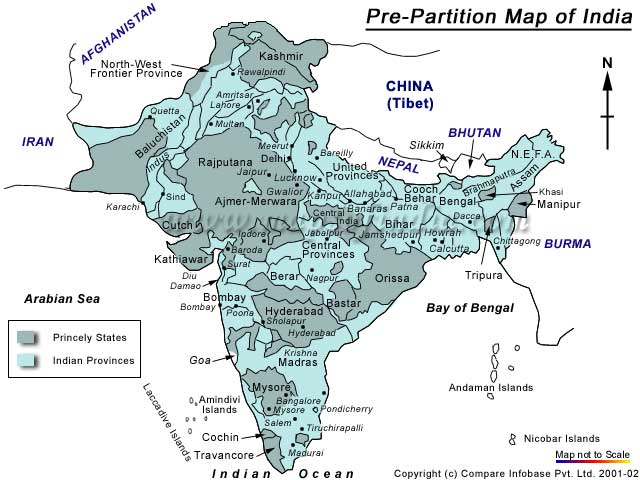
Integration of Princely States
- The relationship of the princely states with the British India had been the product of different treaties signed with the British East India Company and the British Crown, which gave the British Raj varying degrees of control over foreign, inter-state relations and defence. This happened over the course of a century.
- Rulers of the princely states had accepted the suzerainty of Britain in India. Also, these princely states were represented in the Imperial Legislative Council and the Chamber of Princes. Thus, the princes maintained a channel of influence with the British Raj.
- In the run-up to independence, the important question that emerged was the nature and shape of the new state or states that would replace the British Raj. The demand for the partition to create Pakistan was the central issue, though it was not the only one. However, the ‘partition plan’ did not deal with the fate of the princely states, as it confined itself only with the provinces.
- Though the rulers of princely states were technically free to join either Dominion, there were certain geographical considerations which could not be wished away. Out of something like 565 states, the vast majority were irretrievably linked geographically with the Dominion of India. Even after the Congress leadership agreed to partition and to the establishment of Pakistan, the political geography of the new Indian state remained unclear.
- Before the Independence , the development of trade, commerce and communication had bound the princely states with the British India through complex agreements. Without integration of the Princely states, after the Independence, agreements relating to railways, customs, irrigation, use of ports, etc would lapse and thus, would have created a chaotic situation. At the same time, the people of these princely states had also, participated in the freedom struggle and wished to integrate with India.
Instrument of Accession
Sardar Patel and V.P. Menon proposed an official treaty known as ‘instrument of accession’ to the princely states. According to the basic tenets of the treaty, the Government of India would control only foreign affairs, defence and communications, leaving all internal issues to be administered by the states.
More concessions were given by guaranteeing that princes who signed willingly would be retained as constitutional heads of their state, although, they would be ‘encouraged’ to hand their power over to an elected government. Once the Instrument of Accession was signed, the state would be represented in the Constituent Assembly of India; thereby, becoming an active participant in framing of the new Constitution.
Thus, by employing a potent mix of charm, bullying and cajoling, Mountbatten, Patel and Menon managed to get most of the States to accede. Princely states were engaged through social meetings and unofficial surroundings, lobbying them to forestall potential conflicts and to accede to the Indian Union in good faith before the deadline. Patel invoked the patriotism of India’s monarchs, asking them to join in the freedom of their nation and act as responsible rulers who cared about the future of their people, along with issuing an implied threat, that rulers might face popular uprising of their citizens for accession to Indian Union if they did not do so before 15th August 1947.
States
- Due to these efforts, from June to August 15th, 1947, 562 of the 565 India-linked states signed the instrument of accession. Before Independence, Travancore was ruled by C.P. Ramaswamy Iyer, who wished Travancore to remain as an independent country. The communists of the state revolted against the idea and made an attempt on the ruler’s life. Sensing the threat to his life, Iyer resigned. He was succeeded by P.G.N. Unithan. After several rounds of negotiations, the state was acceded to India, in 1949, forming the state of Travancore-Kochi.
- At the time of India’s Independence, Jodhpur was ruled by a young King Maharaja Hanwant Singh. Exploring other options, he thought that Pakistan would give him a better deal then what India was offering and thus, delayed the accession. He even met Jinnah in Delhi where Jinnah promised him many concessions. Patel met with the King and discussed the future developments like imports of arms, need of grains and linking Jodhpur to Kathiawar by rail, etc. At the same time, Patel warned the King that If he decided to join Pakistan then India would not be able to help the state during the communal violence, which was prevalent in Punjab and Bengal at the time. Sensing that his best interest lay in joining India, he acceded on 11th August 1947.
- In return of signing the Instrument of Accession, the princes were given handsome ‘privy purses’, the amount was linked to the revenue earned by each state. The Privy Purse was the incentive given to the rulers of the princely states as part of their agreements to integrate with India.
- However, in the strenuous process of integration, three major conflicts arose that posed a major threat to the Union: Junagadh, Jammu and Kashmir and Hyderabad.
Junagadh
- Junagadh was situated in the Kathiawar region of western India. Though over 70% of its population was Hindu, Junagadh was ruled by a muslim nawab Muhammad Mahabat Khanji III. Also, it did not have a shared land boundary with Pakistan. The Arabian Sea stood between it and Pakistan. Advised by Jinnah, the Nawab delayed the discussion of accession with India and on August 15, 1947 declared its wish of acceding to Pakistan.
- Considering the fact that administrative and economic unity of Kathiawar would be endangered due to Junagadh’s accession to Pakistan, Indian leaders raised concerns, but both Junagadh and Pakistan did not respond. It was also believed that if Junagadh was permitted to go to Pakistan, it would exacerbate the communal tension already simmering in Gujarat. Thus, India imposed an embargo of essential supplies on the state, including coal, petroleum and sugar.
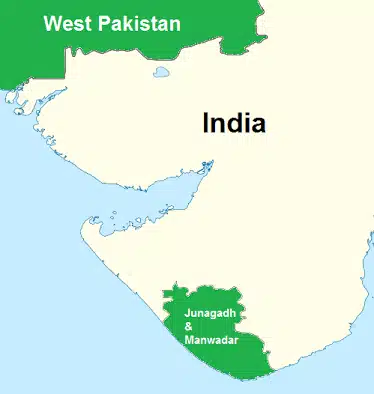
- Later, Pakistan accepted the accession of Junagadh. To resolve the impending issue, India proposed that a referendum or a plebiscite be conducted to decide the future of the state by the people of the state. These kind of instruments were used before also, in the North West Frontier Province and in the Sylhet district of Assam. But Pakistan refused the idea.
- Meanwhile, leaders of the state people’s organizations in Kathiawar went on to form a ‘provisional government’ of Junagadh— an organization that claimed to represent the people of Junagadh and actively worked to overthrow the Nawab’s administration. And, by the end of October 1947, it started occupying pockets of Junagadh territory. Due to this development, the Nawab of Junagadh panicked and fled to Pakistan. As Pakistan was reluctant to send troops to aid Junagadh, the Dewan (now, the in charge after the Nawab fled) asked the Indian government to restore the law and order situation in the state and take over the administration, to which Indian Government complied with alacrity.
- This move was strongly protested by Pakistan, which later raised the issue at the United Nations Security Council. Later, in February 1948, the Indian Government conducted a referendum in Junagadh, which overwhelmingly favored merger with Indian Union.
Jammu and Kashmir
- In Jammu and Kashmir, the situation was peculiar. It shared border with both Pakistan and India. Here, a hindu king Maharaja Hari Singh ruled over a population that was overwhelmingly muslim. The king was reluctant to join both India and Pakistan. He delayed a decision on accession, hoping to keep Kashmir independent and a neutral state.
- The popular political forces led by the National Conference and its leader Sheikh Abdullah, however, wanted to join India.
- The leadership in Pakistan organized a tribal ‘lashkar’ to invade and capture Kashmir, because they feared that Pakistan’s security would be threatened if Kashmir went to India. As the army of the state was unable to cope up with this attack, Maharaja Hari Singh sought India’s military assistance.
- Though, Nehru was against accession without conducting the referendum in the state, India could send its troops to Kashmir only after the state’s formal accession to India under international laws, as pointed out by the then Governor General of India, Lord Mountbatten. Thus, the Maharaja acceded to India on 26th October, 1947. In accordance with its democratic principles, India announced that it would conduct referendum on the accession decision once the situation became peaceful.
- After the accession, Indian leaders immediately took steps to fly troops to Srinagar. Srinagar was first held and then the raiders were gradually driven out of the valley, though, the invaders occupied some areas of the state and armed conflict continued for a month.
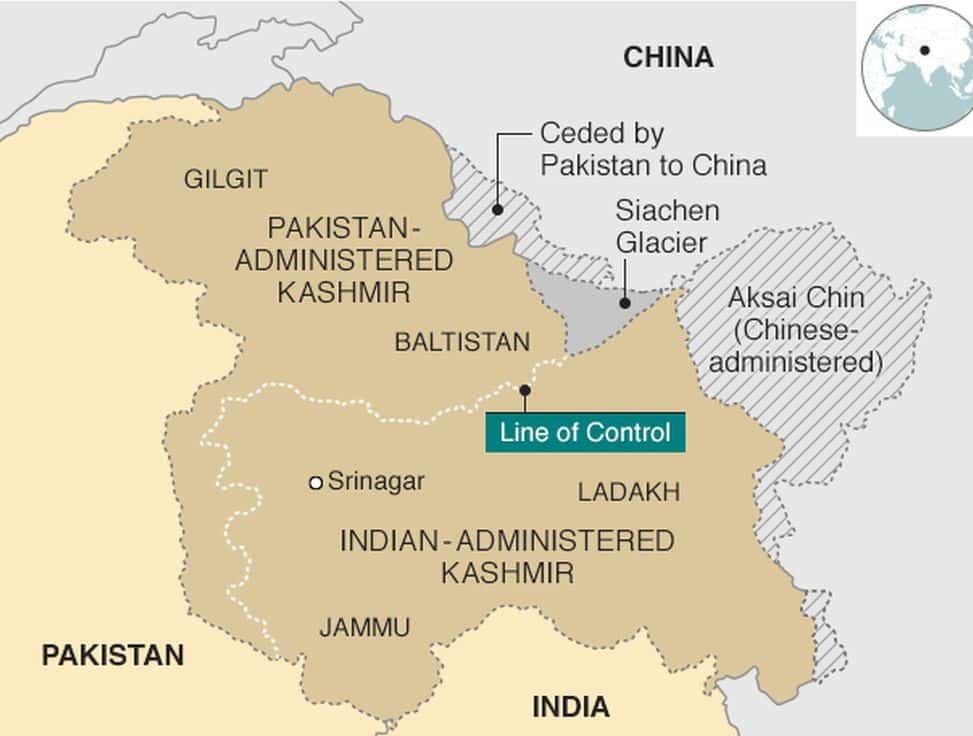
- The Indian government approached the United Nation Security Council against the aggression undertaken by Pakistan in Kashmir. However the UNSC converted ‘Kashmir question’ into ‘India-Pakistan dispute’. Following a resolution of the UNSC, both India and Pakistan accepted a ceasefire on 31st December,1948 which is still prevailing. In 1951, the UN passed a resolution providing for a referendum under UN supervision after Pakistan had withdrawn its troops from the part of Kashmir under its control. The resolution has remained infructuous since Pakistan has refused to withdraw its forces from what is known as Azad Kashmir.
- Since then India has regarded Kashmir’s accession as final and irrevocable and Kashmir as its integral part. Pakistan continues to deny this claim.
Hyderabad
- Similar to Junagadh, in a way, Hyderabad was also ruled by a muslim leader, Nizam Usman Ali Khan, presiding over a population of nearly 16 million, over 80% of them being hindus. But Hyderabad carried much greater importance as it was the largest state at that time, completely surrounded by Indian Territory, located in central India.
- Thereby, without Hyderabad, there would be a large gap in the center of the Indian Territory, potentially posing a constant threat to India’s security in the future. Thus, Hyderabad was essential for India’s unity.
- After several rounds of negotiations, India signed a “Standstill Agreement”, a temporary and year-long agreement, maintaining the status quo.
- India signed this temporary agreement, hoping that Nizam would introduce representative government in the state, while the negotiations continued. But, Nizam’s intentions were to delay the process and expand his military strength so as to force India to accept his independence or succeed in acceding to Pakistan owing to tension between India and Pakistan over Kashmir.
During the period, there were three important political developments taking place within the state.
- There was a rapid growth of the militant muslim communal organization, Ittihad-ul-Muslimin and its paramilitary wing, the Razakars, creating violence leading to thousands of people fleeing the state and taking shelter in temporary camps in Indian territory.
- On 7th August 1947, Hyderabad State Congress launched a powerful satyagraha to force democratization on the Nizam, due to which around 20,000 Satyagrahis were jailed.
- A powerful communists led peasant struggle had developed in the Telangana region of the state from the latter half of 1946. The movement, which had waned due to the severity of state repression by the end of 1946, recovered its vigour when peasant dalams(squads) organized defence of the people against attacks by the Razakars, attacked big landlords and distributed their lands amongst the peasants and the landless.
The Nizam made no moves towards introducing even a measure of representative government; instead, he kept on delaying the negotiations. At the same time, he kept on importing more and more arms to strengthen his army. Due to these developments, the situation was becoming volatile. To control the situation, Indian Army moved into Hyderabad on 13rd September 1948. The Nizam surrendered within three days and Hyderabad was acceded to Indian Union in November 1948.
Accession of Hyderabad was a symbol of victory of secularism in India as large number of muslims, both in Hyderabad and in the rest of the country, supported the government’s policy and actions against the Nizam to the dismay of the leaders of Pakistan and the Nizam.
Rest of the States
- The second and the more difficult stage of the full integration of the princely states into the new Indian nation began in December 1947. Once again Sardar Patel moved with speed, completing the process within one year. Smaller states were either merged with the neighbouring states or merged together to ‘form centrally administered areas’.
- In return for their surrender of all power and authority, the rulers of major states were given privy purses in perpetuity, free of all taxes. The privy purses amounted to Rs 4.66 crore in 1949 and were later guaranteed by the constitution. The rulers were allowed succession to the gaddi and retained certain privileges such as keeping their titles, flying their personal flags and gun salutes on ceremonial occasions.
- Also, there were French and Portuguese owned settlements on India’s east and west coasts with Pondicherry and Goa forming their hub. Popular sentiments, in these settlements, were in favor of joining the Indian Union. After a long period of negotiations with French authorities, Pondicherry and other French possessions were handed over to India in 1954.
- But Portuguese did not want to handover their territories, especially as Portugal’s NATO allies, Britain and the US, were willing to support this defiant attitude. People of Goa started a movement seeking freedom from the Portuguese but were brutally suppressed. After a long period of patience, the Indian Army was ordered to liberate Goa on 17th December 1961. The Governor-General of Goa surrendered without a fight. Thus, in a span of fourteen years, political integration of India was completed.
Role of Sardar Vallabh Bhai Patel
Sardar Patel effectively handled the integration of the princely states with his diplomatic skills and
foresightedness. The problem of amalgamating 565 independent states within a democratic self governing India was difficult and delicate. But it was essential to save India from balkanization, once
the Paramountcy of British crown had lapsed. He played a decisive role in integrating the princely states in the following way:
- Sardar Patel was the Minister for Home and States Affairs, and was given the explicit responsibility of welding a united and strategically secure India in time for the transfer of power.
- Sardar Patel, along with V.P. Menon, was instrumental in formulating the Instrument of Accession, a balanced treaty to ensure the integration of princely states with Indian Union.
- Patel followed an Iron-handed policy, giving primacy to the unity of India.
- Due to Patel’s reputation for firmness and even ruthlessness sometimes, most of the princes responded to his appeal to accede to India by 15 August 1947.
- At several instances, he used both persuasion and pressure as well as invoked the patriotism of the monarchs.
- Patel, also, worked towards addressing the concerns of monarchs with respect to their relationship after acceding to India, thus, accelerating the integration process.
- He carried out the task of integrating Junagadh as a skilled statesman, without which, Junagadh would have been a part of Pakistan today. He also subdued the Nizam of Hyderabad tactfully.
Clearly, due to Sardar Patel’s masterful diplomacy and pragmatism, the process of integration of the princely states was completed without causing any civil war and, thus, balkanization of the country was successfully avoided.
Partition and its Aftermath
Partition
- To prolong their rule in India, the British had followed a divide-and-rule policy. They based their knowledge of the peoples of India on the basic religious texts and the intrinsic differences they found in them, instead of on the way they coexisted in the present. They also feared a potential threat from the muslims who ruled India for over 300 years under the Mughal Empire.
- By the end of the 19th century, there were many nationalistic movements going on in the country. At one hand, the Indian National Congress was calling for Britain to quit India, on the other hand Muslim League, in 1940, passed a resolution for them to ‘Divide and Quit’. There were several reasons for the birth of a separate muslim homeland in the subcontinent, and all three parties-the British, the Congress and the Muslim League were responsible.
- After the Second World War, Britain simply no longer had the resources with which to control its greatest imperial asset, and its exit from India was messy, hasty, and clumsily improvised.
- The break-up of Britain’s Indian empire involved the movement of some 12 million people, uprooted, ordered out, or fleeing their homes and seeking safety. The violence polarised communities on the subcontinent as never before.
- Partition led to creation of two sovereign countries, Pakistan on 14th August 1947 and India on 15th August 1947. This led to the division of the Bengal province of British India into East Bengal of Pakistan (later Bangladesh) and West Bengal of India. Similarly, Punjab region of British India was divided into the Punjab province of West Pakistan and the Punjab state of India. At the same time, the event led to division of the defence force, the civil services, the treasury and other assets.
Aftermath
The partition had repercussions on every sphere-social, economic and political.
Social Impact
- The immediate result of partition was violence. Communal riots took place throughout the country destroying lives, wealth and resulting in bitterness between the two communities. In Punjab and Bengal—provinces, abutting India’s borders with West and East Pakistan, respectively— the carnage was especially intense, with massacres, arson, forced conversions, mass abductions, and savage sexual violence.
- Moreover, after India attained independence, the minorities were affected directly in the areas of partition. Their fate was in a perilous situation; in addition to this, the ‘direct action’ campaign by the Muslim league was followed by the Calcutta killing and disturbances in the Naokhali district of East Bengal.

Political Impact
- The partition reported to have displaced about 12 million to 15 million people in the former British Indian Empire.
- The partition also meant division of territories. For this purpose, Cyril Radcliffe, the British civil servant was handed the daunting job of working out the border on the map. The line in question is the international boundary between India and Pakistan which was hurriedly drawn up in the summer of 1947, almost immediately prior to independence and partition that year. In their rush to achieve their own political goals, British India decided not to complete territorial partition before final political separation. This decision left Indian and Pakistani citizens in the peculiar predicament of not knowing which country they were in, on August 15th or 16th. Additionally, Mountbatten’s delay in announcing the Radcliffe Line meant, effectively, that India and Pakistan had no boundaries for the first two days of their existence. This heightened the level of violence and many perished, who could have otherwise been saved.
- The biggest effect is definitely, the Kashmir issue. India was able to solve its tussles with the states of Junagadh and Hyderabad, but Kashmir was tricky as it lay on the border. The issue is still unresolved today and has become a major propaganda instrument for terrorist organisations in Pakistan and India.
Economic Impact
- With the partition, 77% of the territory and nearly 82% of the population of undivided India was left with India. The rest went to Pakistan. Partition affected India’s economy, also. Some of the important industries; namely the jute and cotton were adversely affected. Due to partition, important raw jute and cotton growing areas went to East Pakistan (now called Bangladesh), while the mills were located in India. Shortage of raw material was also experienced by the paper, leather tanning and some chemical industries in wake of partition.
- Partition also resulted in loss of market by creating a gap in demand for products like cotton textile, glass, Aluminium, vegetable oils, rubber, goods, foot wears etc., which used to come from areas that went to Pakistan. Partition resulted in dislocation of transport and communication facilities in the country. The railway network of undivided India was also disrupted by partition, Indian union obtaining 24,565 miles and Pakistan 6,748 miles. Immediately after partition, there was an atmosphere of uncertainty and suspense. This seemed to have shaken the confidence of private enterprises in the country affecting the level of investment adversely.
Linguistic Reorganization of States
- The principle of linguistic provinces had no precedent in the history of India. The boundaries of the states changed in accordance with the changing strength and abilities of the kings. British conquest of India continued for nearly hundred years but they also did not pay any attention towards proper reorganization of the territory based on languages. Thus, most of the provinces were multilingual and multicultural.
- Arguments in favour of reorganization of states on linguistic basis:
- Day-to-day administrative works become easier, if done in one language.
- In India, language is closely related to culture and customs.
- Democracy holds real meaning to the common people when politics and administration are conducted through the language they understand.
- It is for this reason that, with the involvement of the masses in the national movement after 1919, Congress undertook political mobilization in the mother tongue and, in 1921, amended its constitution and reorganized its regional branches on linguistic basis. Since then, Congress repeatedly committed itself to the redrawing of the provincial boundaries on linguistic lines.
- The division of India during the British period into British provinces and Indian States was itself fortuitous. At the time of independence in 1947, India consisted of 565 disjointed princely states that were merged together to form 27 states. The grouping of states at the time was done on the basis of political and historical considerations rather than on linguistic or cultural divisions, but that was a temporary arrangement.
- It is for this reason that, with the involvement of the masses in the national movement after 1919, Congress undertook political mobilization in the mother tongue and, in 1921, amended its constitution and reorganized its regional branches on linguistic basis. Since then, Congress repeatedly committed itself to the redrawing of the provincial boundaries on linguistic lines.
- The division of India during the British period into British provinces and Indian States was itself fortuitous. At the time of independence in 1947, India consisted of 565 disjointed princely states that were merged together to form 27 states. The grouping of states at the time was done on the basis of political and historical considerations rather than on linguistic or cultural divisions, but that was a temporary arrangement.
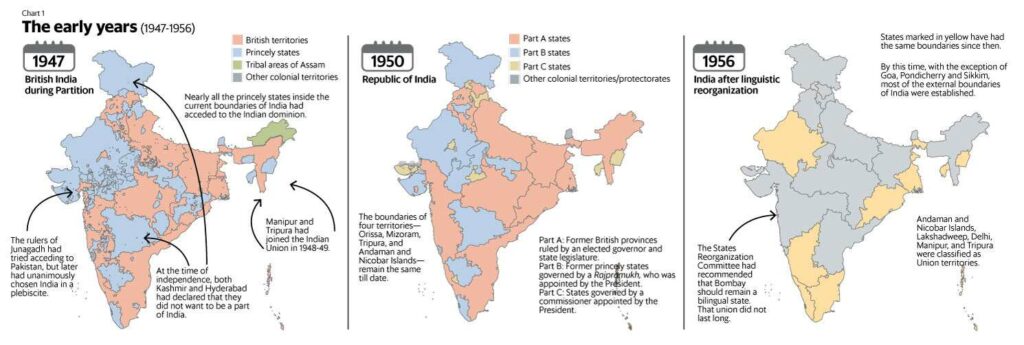
Reasons to Delay the Reorganisation Process
- Partition had created serious administrative, economic and political dislocation.
- Independence, coming immediately after the Second World War, was accompanied by serious economic and law and order problems.
- There was Kashmir issue and a war like situation with Pakistan, along with the communal situation in India, in aftermath of the Partition.
- The government felt that the most important task for the present was to consolidate national unity.
- Any effort undertaken immediately to redraw the internal boundaries might dislocate administration and economic development, intensify regional and linguistic rivalries, unleash destructive forces, and damage the unity of the country.
JVP Committee
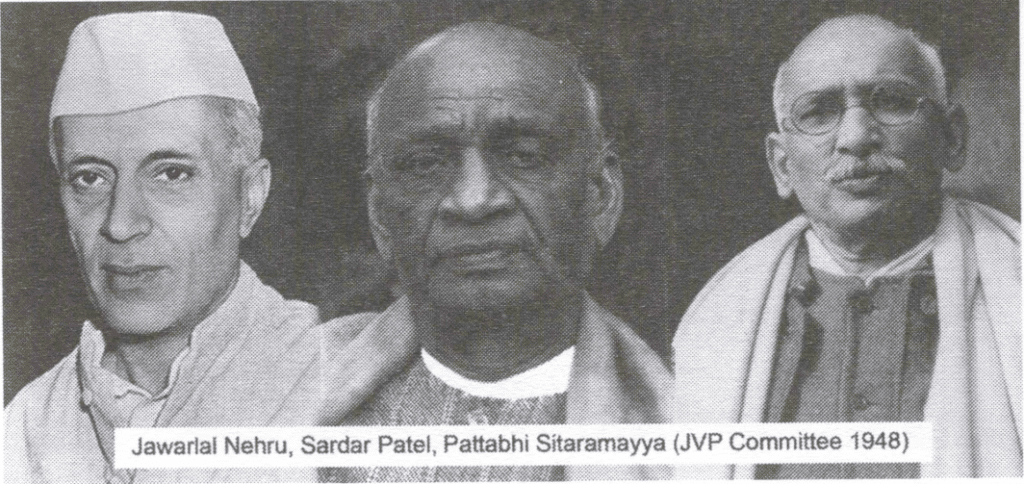
The Linguistic Provinces Commission, chaired by Justice S.K. Dhar , was appointed in 1948. The commission did not favor reorganization of states based on linguistic criteria as it could threaten national unity. But there was a constant demand and protest, especially in South India for the
linguistic reorganization. Thus, in December 1948, the JVP Committee comprising Jawaharlal Nehru, Vallabhbhai Patel and Pattabhi Sitaramayya was formed to study the issue. The Committee, in its report submitted in April 1949, rejected the idea of reorganization of states on a linguistic basis for
the time being, emphasizing on unity, national security and economic development as the need of the hour.
Potti Sriramalu Incident

Madras Presidency had many different languages. There was a strong case for formation of Andhra Pradesh out of Madras Presidency but the sides were divided on the question as to which state should take the Madras city. This prolonged the issue.
In October 1952, a veteran Congressman named Potti Sriramulu went on a fast demanding the immediate constitution of Andhra State. The Chief Minister of Tamil Nadu, C. Rajagopalachari, and the Prime Minister, Jawaharlal Nehru ignored him. But Sriramulu was undeterred.
He undertook hunger strike and , died during the night of 15/16 December after 56 days without food. His martyrdom provoked widespread public anger, with hartals and dharnas held across the Telugu speaking areas, and demonstrators attacking and burning government offices and railway stations. The government immediately gave in and conceded the demand for a separate state of Andhra, which finally came into existence in October 1953. Simultaneously, Tamil Nadu was created as a Tamil speaking state.
Sons of the Soil Doctrine
“Sons of the soil doctrine” has led to regionalism since 1950s. It dwells on the view that a state, with its resources, mainly belongs to the main linguistic group of the state, called ‘sons of the soil’ or the ‘local’ residents. All the others, even if they have lived there for a long time but is their mother tongue is not the state’s main language, were to be treated as ‘outsiders’. The ‘locals’ portrayed their group as indigenous, and as rightfully possessing the area as their group’s ancestral home. Thus, language loyalty and regionalism was used to systematically exclude the ‘outsiders’ from the economic life of a state or city.
Reasons behind this Doctrine
- The economy’s failure to create enough employment. opportunities for the recently educated created an acute scarcity of jobs, and led to intense competition for the available jobs during the 1960s and 1970s.
- These movements have mainly arisen, and have been more virulent, when there is actual or potential competition for industrial and middle-class jobs, between the migrants and the local educated middle class youth.
- The movement has been more intense in states and cities where ‘outsiders’ had greater access to higher education and occupied more middle-class positions in government service, professions and industry and were engaged in small businesses, such as small scale industry and shop keeping.
The issue was more intensified in those cities where the speakers of the state language were in a minority or had a bare majority, for example in Bombay in 1961, the Marathi speakers constituted 42.8 per cent of the population. In Bangalore, the Kannada speakers were less than 25 per cent.
Also, majority of middle-class job opportunities, after 1952, were in government service and the public sector enterprises. Thus, many politicians mobilized the people on this ground to put pressure on the government. They took advantage of the ‘sons of the soil’ sentiment for gaining political power. They claimed that the ‘local’ people in the states concerned are socially, economically and educationally backward and are not able to compete with the more advanced migrant communities; thus, they
should be provided with reservation. Reservations on grounds of residence have also been approved by the courts.
States Reorganization Act (1956)
- After the creation of Andhra, other linguistic communities also demanded their own separate states.
- Thus, to deal with the problem holistically, the government formed the States Reorganisation Commission (SRC), with Justice Fazl Ali, K.M . Panikkar and Hridaynath Kunzru as members, to examine ‘objectively and dispassionately’ the entire question of the reorganization of the states of the Union in August 1953. The commission submitted its report after two years, in 1955. The commission recognized the linguistic principle for redrawing of the state boundaries, though it emphasized giving due importance to administrative and economic factors. The government accepted the commission’s recommendations, though with certain modifications, and quickly implemented them.
- The States Reorganization Act was passed by the parliament in November 1956. It provided for fourteen states and six centrally administered territories. Under this new amendment, the existing distinction amongst Part A, Part B, Part C and Part D states were done away with and they came to be known as the “states”, while the Part C and Part D states were replaced by a new entity of “Union Territory”.
- As a result of the Act, the Telangana area of Hyderabad state was transferred to Andhra; Kerala was created by merging the Malabar district of the old Madras Presidency with Travancore-Cochin. Certain Kannada-speaking areas of the states of Bombay, Madras, Hyderabad and Coorg were added to the Mysore state. Bombay state was enlarged by merging the states of Kutch and Saurashtra and the Marathi speaking areas of Hyderabad with it.
Issue of Maharastra and Gujarat
The commission had opposed dividing Bombay and Punjab. There were widespread protests and violence in the Bombay city for splitting the state. Under pressure, the government divided the Bombay state into two linguistic states Maharashtra and Gujarat, and making Bombay city a centrally administered state. Again, there were protests by the Maharashtrians against this move and they demanded Bombay city be included in the Maharashtra state. The Gujaratis opposed the demands of the Maharasthrians as they felt that they would be a minority in the new state. This led to large scale violence which spread to Ahmedabad and other parts of Gujarat. The government finally agreed in May 1960 to bifurcate the state of Bombay into Maharashtra and Gujarat, with Bombay city being included in Maharashtra, and Ahmedabad being made the capital of Gujarat.
Issue of Punjab
The States Reorganisation Commission maintained that Punjabi was not sufficiently distinct from Hindi and the demand for a Punjabi-speaking state is a disguise for a religion based Sikh state. This was seen as a discrimination against the Sikh minority as all other 14 languages in the Constitution were granted statehood.
After a struggle lasting for more than a decade, in 1966, the Sikhs were granted a state. Punjab was divided into Punjabi-speaking (and Sikh-dominated) Punjab and Hindi-speaking (and Hindu-majority) Haryana. In addition, six of Punjab’s mountainous regions were transferred to Himachal Pradesh.
Thus, after more than a decade of continuous struggle, the reorganization of states based on linguistic criteria was largely over. By doing so, the aspirations of people were satisfied and the platform was set for national integration.
Also, the fear that the linguistic reorganization of states would weaken the federal structure, has been unfounded. On the other hand , with the rationalization of the political map of the nation, the nation stands to benefit as the states have become more functional and coherent units in the overall Indian Union.
Integration of Tribals in India
Tribals spread all over the country and had their own distinct culture, languages and ways of life. They mainly resided in hilly and forested areas, in relative isolation as compared to non-tribal neighbors. They constituted about 6.9 percent of population. Except in the Northeast, they constitute minorities in their other home states.

During colonialism, the relative isolation of tribals was eroded to some extent. This led to their exploitation as they were reduced to agricultural laborers and their relations with forests were also destroyed. The tribals depended on forests for food, fuel and cattle feed and for raw material for their handicrafts. Thus, they were driven to abject poverty and indebtedness. Loss of land, indebtedness, exploitation by middlemen, denial of access to forests and forest products, and oppression and extortion by policemen, forest officials, and other government officials was to lead to a series of tribal uprisings in the nineteenth and twentieth centuries—for example, the Santhal uprising and the Munda rebellion led by Birsa Munda.
Difficulties in Tribal Integration
- Their primitive way of life.
- Economic and social backwardness.
- Low level of literacy.
- Hackneyed system of production.
- Absence of value system.
- Sparse physical infrastructure in backward tribal areas.
- Demographic quality of tribal areas.
The above mentioned problems made it imperative for a systematic process of development of tribes and tribal areas.
Theories of Integration
The Indian tribal society is a unique society with diversity of nature and people. In our country, known for the extreme poverty of the masses, the tribes constitute the core of the poor. They also have distinct culture and way of life which is closely associated to forests and nature and, hence, a balance was needed which would ensure that they get their rightful share of country’s development while protecting their rights and preserving their unique culture. Thus, integration of tribals represented an extremely complex problem.
Isolation Theory
Also, one way of dealing the tribal issue was of keeping them segregated i.e. leaving the tribal people alone, ensuring their cultural linkages remain undisturbed from the mainstream society’s culture which was foreign to them. It would preserve their way of life but this meant that their society would continue to face many problems which could otherwise, be resolved with modern developments in areas like health and education among others.
Assimilation Theory
At the same time, quick assimilation of tribal people with the Indian society would definitely lead to their development vis-a-vis the non-tribals. But this would destroy their social and cultural identity and many other virtues they possess. In fact, this would ultimately lead to possession of tribal lands by the outsiders which would further push them in perpetual poverty.
Critical Analysis
Thus, both approaches given above, isolation and assimilation of tribal people, were rejected. Instead Nehru advocated progressive integration of tribal people into the Indian society while preserving their distinct identity and culture. This approach was based on the basic understanding that “the tribal areas have to progress and they have to progress in their own way and at their own pace”. In essence, the tribals would themselves decide the changes they need and also these changes would be adopted by them gradually. Thus, the problem now was how to combine these two seemingly contradictory approaches.
Tribal Panchsheel (Nehruvian Approach)
The solution was the delicate balance of the two approaches. Nehru advocated for social and economic development of the tribals, which in turn, would empower them in the long run, and their gradual integration with the Indian society. For this, five fundamental principles were laid down for tribal development:
- The tribals should develop along the line of their own genius. We should try to encourage in every way their own traditional arts and culture. There should not be any compulsion or imposition from outside.
- To preserve the relationships that the tribals enjoy with forests, tribal rights to land and forest should be respected. There should not be any encroachment of tribal lands by outsiders.
- Results should be judged not by statistics or the amount of money spent, but by the human character that is evolved.
- The tribals, themselves, should be relied upon for the administration of their areas, for which administrators should be recruited from amongst themselves and trained. Introduction of outsiders in the administration should be kept to a minimum and, also, those outsiders be recruited who have a sympathetic and understanding approach.
- Also, there should not be over-administration of tribal areas. The effort should be to administer and develop the tribals’ through their own social and cultural institutions.
Steps Taken
To implement these principles, many steps were taken up.
- Under Article 46 of the Constitution, the state should promote with special care, the educational and economic interests of the tribal people and should protect them from social injustice and all forms of exploitation, through special legislation.
- The governors of the states in which tribal areas were situated were given special responsibility to protect tribal interests, including the power to modify central and state laws in their application to tribal areas.
- The constitution also extended full political rights to the tribal people. In addition, it provided for reservation of seats in the legislatures and positions in the administrative services for the Scheduled Tribes as in the case of the Scheduled Castes.
- The constitution also provided for the setting up of Tribal Advisory Councils in all states containing tribal areas to advise on matters concerning the welfare of tribals. A Commissioner for Scheduled Castes and Scheduled Tribes was appointed by the President to investigate whether the safeguards provided for them were being observed.
Legislative as well as executive action was taken by the state governments to prevent loss of tribal lands to non tribal people and to prevent exploitation of the tribals by moneylenders. The central and state governments created special facilities and organized special programmes for the welfare and development of the tribal areas and the tribal people including the promotion of cottage and village industries and generation of employment amongst them.
Issue of Official Language
The issue was of deciding an official language and not of the national language of India. National language would mean that it would be adopted by all the Indians after some time. The idea of a single national language was rejected as India was a multilingual country and it had to remain so. The constitution-makers virtually accepted all the major languages as “languages of India”. But there was a need of one common language in which the central government would work and keep contact with the states, as the work could not be carried out in so many different languages. Thus arose the question of choosing the official language.
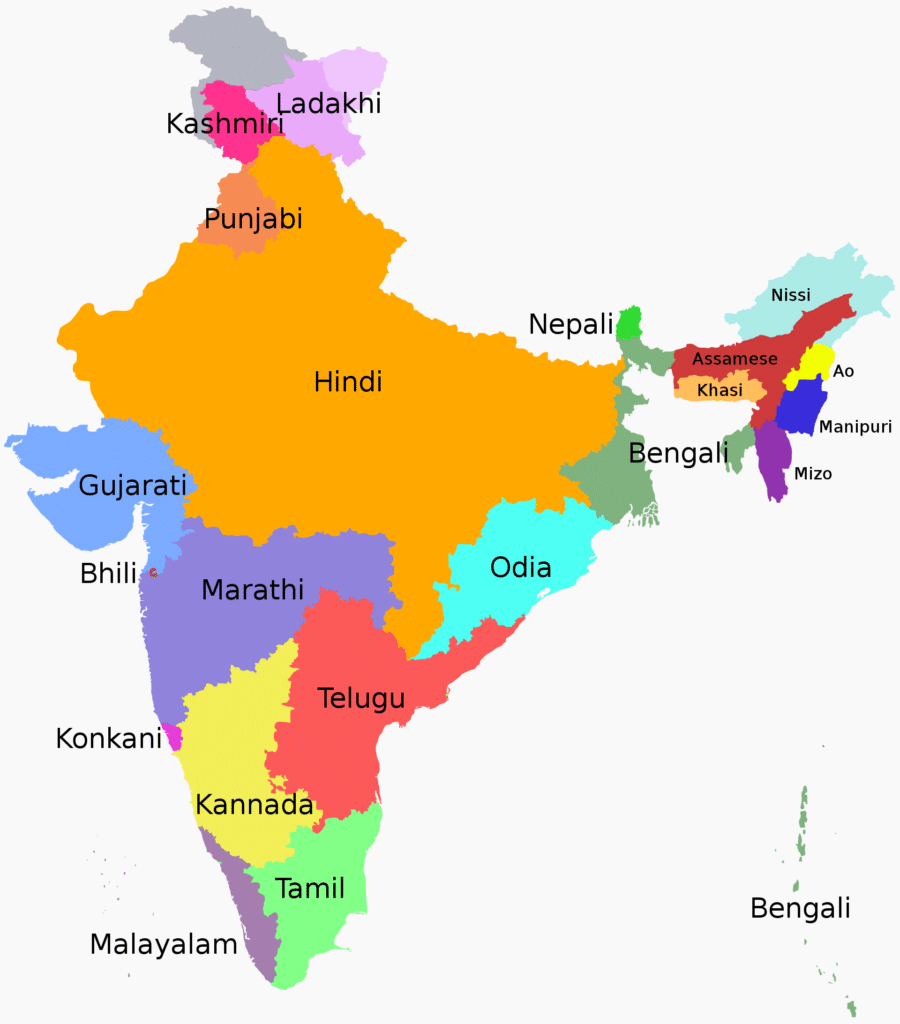
Languages with Official Status in India
There were only two real options for this purpose: Hindi or English. But English was rejected during the pre independence period when the national leaders were convinced that English could not continue as All-India medium for communication. The Nehru report of 1928 had laid down that Hindustani which might be written in the Devanagari or Urdu script would be the common language of India. The real debate in the Constituent Assembly occurred over two questions: Would Hindi or Hindustani replace English? And what would be the time-frame for such a replacement to happen?
For the first question of choosing between Hindi and Hindustani, there were fierce debate. Gandhiji favored Hindustani as the national language as it represented an amalgam of Hindi and Urdu; thus, presented a compromise between Hindi and Urdu languages. Though with the partition, the support for Hindustani dwindled as it had clear linkages with Urdu language. Thus, Hindi was decided against Hindustani by a slight margin, but it was a minor issue. Thus, it was proposed that Hindi be made the official language of the country as it was the mother tongue of 40 percent of people living in India and was also understood by a large population of non-Hindi speaking people. On the second question, the constituent assembly heatedly debated as the Hindi-proponents wanted immediate switchover to Hindi while non-Hindi ones wanted English to continue for a long time. Non-Hindi speakers were fearful of the fact that the adoption of Hindi as the official language would put the non-Hindi speaking areas, especially South India at disadvantageous position in educational and economic spheres as they would tend to lose competition in government and public sector employments. As the language is intimately linked with culture, the protestors also alleged that this imposition is nothing but a strategy aiming Aryanisation of entire country . Also, it was feared that the imposition of Hindi on non-hindi speaking area would eventually led to other languages losing prominence; therefore, the diversity of cultures would also lose importance leading to a cultural homogenization the country.
The Indian National Congress won the 1937 election in Madras Presidency and C. Rajagopalachari became the Chief Minister. He was a staunch supporter of Hindi language as he announced his intention to introduce Hindi language teaching in secondary schools. This led to a widespread protests in the Presidency. Police force was used to crush the protests. This policy of mandatory education of Hindi was later withdrawn by the British Governors of Madras after the resignation of Congress in 1939. During the constituent assembly debate on national language, Tamil Nadu was at the forefront leading the anti-Hindi protests in South India.
Thus, a compromise was reached in the constituent assembly where it was provided that Hindi in Devanagari script with international numerals would be India’s official language. English was to continue for use in all official purposes till 1965, when it would be replaced by Hindi. During that period, Hindi was to be introduced in a phased manner, making it the sole official language after 1965. Though, it gave power to the parliament to provide for the use of English even after 1965.
It was hoped that by 1965 with the rapid growth of education, Hindi would also spread in hitherto untouched areas but the spread of education was too slow. At the same time, the extremists of Hindi-supporter started demanding imposition of Hindi through government action, rather than gradual and moderate approach to gain acceptance by the non-Hindi speakers. This created suspicion and anxiety amongst the non-Hindi speakers. Also, the Hindi protagonists tried to Sanskritize the language which drove away many Hindi speaking supporters also.
Official Languages Act (1963)
The Official Language Commission, set up in 1955 in terms of a constitutional provision, submitted the report recommending that Hindi should start replacing English progressively in various activities of the Central government. The President issued an order in 1960 to implement these recommendations. Hindi was also to become an alternative medium for the UPSC examinations after some time. All these developments created anxiety in the non-Hindi speaking areas.
To allay the fears of non-Hindi speakers, Nehru gave a definite assurance in parliament on 7th August 1959 that the official language would not be imposed on any region without their willing consent. For this effect, an Official Language Act was passed in 1963. The stated objective of the act was to remove a restriction placed on the use of English after 1965. The act provided that English language, in addition to Hindi, may (in place of ‘shall’) be continued to be used for the official purposes of the union beyond
1965 also. The act was considered ambiguous by the nonHindi speakers.
After the death of Nehru in June1964, the non-Hindi speaker’s apprehensions were fuelled by the Shastri government’s announcement of considering making Hindi an alternative medium in public service examinations, which would have given an advantage to Hindi speakers.
This led to widespread protests, especially in Tamil Nadu. The changeover date was to be 26th January 1965. However, on 17th January itself, a strong anti-Hindi movement developed in Tamil Nadu. Here students were highly active and raised slogans “Hindi never, English ever”, as they feared losing employments in All-India Services. This movement spread to the whole state and widespread protests and violence occurred. Many youths burnt themselves in protests and the movement continued for months.
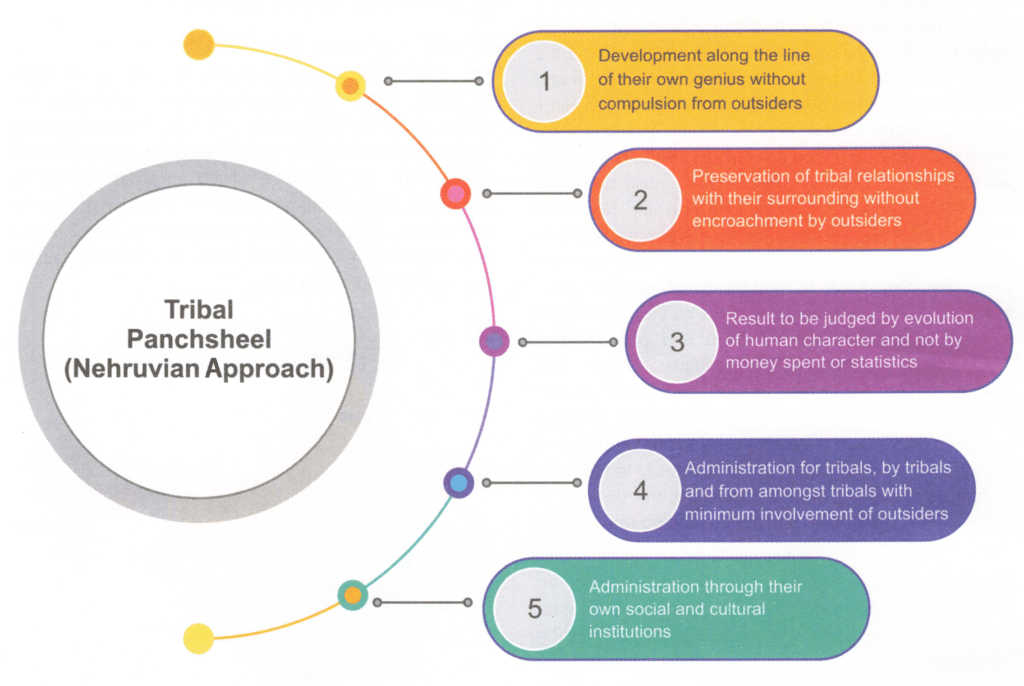
Later, in 1967, Indira Gandhi government, after coming to power, amended the Official Language Act of 1963. It provided that the use of English as an associate language, in addition to Hindi for the official work at the Centre and for communication between the Centre and non-Hindi states would continue as long as the non-Hindi states wanted it. Also, the public service examinations were to be conducted in Hindi and English and in all the regional languages with the provision that the candidates should have additional knowledge of Hindi or English. The states were to adopt a three-language formula according to which, in the nonHindi areas, the mother tongue, Hindi and English or some other national language were to be taught in schools while, in the Hindi areas, a non-Hindi language, preferably a southern language, was to be taught as a compulsory subject. Thus, after a very long struggle and negotiations,
India was able to find a widely accepted solution to the extremely complex and difficult problem.
Hindu Code Bill
Hindu society had been unfairly in favor of male when it came to right to property, order of succession, marriage, and divorce among81 other things. This had been the major cause of continuous degrading of position of women in the Indian society. Thus, the Hindi Code Bill aimed to liberalize the Hindu personal laws which have been ambiguous and contradictory owing to non-codification of its provisions.
The bill aimed to broaden the freedom of the individual and to ensure the equality of men and women in the Hindu social system.
The Hindu code bill was introduced in the constituent assembly on 11th April 1947 by Dr. B.R. Ambedkar. The bill mainly covered right to property; order of succession to the property; and maintenance, marriage, divorce, adoption, minority and guardianship . The bill was inconclusively debated for almost 4 years in the assembly as it was divided on the issue. Major opposition to bill came from the orthodox elements of the constituent assembly.
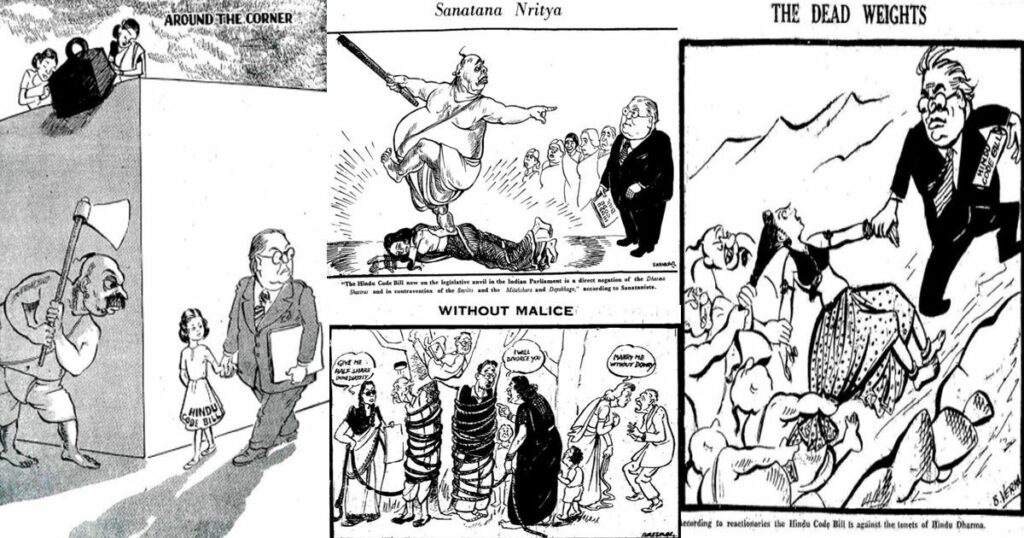
After the first elected parliament started working, the bill was divided into four components and was introduced as separate bills. The Special Marriage Bill, The Hindu Marriage Bill, The Hindu Succession Bill, The Hindu Minority and Guardianship Bill and The Hindu Maintenance and Adoption Bill were all passed by 1956. Special Marriage Act 1954 permitted marriage of people from different religious faiths without changing their religion. Similarly, Hindu Marriage Act 1955 fixed minimum age for marriage as 18 years for girls and 21 year for the boys. The Act also provided for monogamy. Also, under the Hindu
Succession Act 1956 a woman’s right of inheritance was fully recognized.
Criticism
Though the bill was applauded for giving women their due place, it was also criticized on the ground that similar disabilities existed in other religions also and, thus, the same law should have been made applicable to all the citizens irrespective of their religions. However, most of the personal laws derive their legitimacy from the religion itself, common application of civil laws to all (i.e. Universal Civil Code) might violate the constitutional protection of religious freedom and, thus, the debate is still going on the issue of Universal Civil Code.
Political Developments
Parliamentary Democracy
Parliamentary democracy stands for a form of government in which the people rule through elected representatives. These representatives reflect the will of the people. But, before Independence, there was a complete disconnect between the representatives of the people in the Central Legislative Assembly and the government of the day .
After Independence, things naturally underwent a change. The parliamentary form of democracy was chosen because India had a long history of association with this system as a part of colonial legacy. Thus, parliament became the principal forum where national problems were discussed, debated in full public gaze.
The period between August 1947 and March 1952 was very significant as it led to the formation of the constitution as well as bridged a gap between the old legislative assembly and the newly elected parliament. After the completion of task of framing the constitution by the Constituent Assembly, the first ever elections were announced in 1951. Despite the fact that majority of the people were poor and illiterate, India was able to ensure free and fair elections. More than half the eligible voters turned out to vote on the day of elections. India’s general elections of 1952 became a landmark in the history of
democracy all over the world.
During the elections, the election commission also faced an issue of identification theft during the voting process. To overcome this issue, Indian scientists made indelible ink (a semi-permanent ink that is applied to forefinger). This also aimed to stop the voters from casting their votes twice.
One Party Dominated System
During the Nehru years, the Indian National Congress retained power in the center as well as in the majority of the states. There were many reasons for that. The party was seen as the party of freedom movement and having an inclusive ideology. The party was the most important political organization in India at independence as there was no real alternative to it, at least during the Nehruvian era. It was so because it enjoyed immense prestige due to its role in the independence of the country. At the same time, the party hugely befitted from the stalwarts like Jawahar Lai Nehru, Vallabh Bhai Patel and Rajendra Prasad amongst others.
The dominance of the Indian National Congress was also due to the inability of the opposition parties to unite and give a challenge to the Congress. After the independence, a multiparty system developed from the beginning. There were many political parties including the Congress, the Communist party and the Bhartiya Jan Sangha among others. Due to all these factors, the Indian National Congress was expected to win the first elections, though the extent of its victory surprised many as it won 364 of
the 489 seats in the first Lok Sabha. The state elections were also held with Lok Sabha elections and the INC again scored big victories. Except Travancore-Cochin, Madras and Orissa, it won majority of seats in all the states. Even, in these states, it finally formed the governments. Thus, the INC was in power all over the country and this dominance continued in the second and third general elections held in 1957 and 1962 respectively.
Decline of Indian National Congress
By fourth general elections Congress’s dominance over the country had significantly declined. The general elections were conducted in 1967, and before that the country had lost two Prime Ministers, Nehru (27th May 1964) and Lai Bahadur Shastri (11th January 1966). Thus, the INC was going to the elections without Nehru for the first time. Indira Gandhi, who assumed power after the death of Shastriji, was being seen as a political novice. Also, this time, the INC was significantly weaker due to internal factionalism.
At that time, the country was going through a grave period of economic crisis due to successive monsoon failures, droughts, food shortages, depletion of foreign exchange reserves, drop in industrial production and exports, combined with a sharp rise in military expenditure and diversion of resources from planning and economic development. People started protesting which the government failed to understand. This led to decrease in popular faith in the government. Also, the opposition parties united to form anti-congress fronts even when they had diverging ideologies. This strategy came to be recognized as ‘non-Congressism’. For example, CPI and CPI(M) forming the United Front government with dissident members of Congress.
All these factors led to decline of the grand old party in the election of 1967. At the Centre, the Congress was able to secure a majority in the Lok Sabha. Plowever, it went on to win the lowest number of seats and share of votes since 1952. At the state level, the situation was more dramatic. The Congress lost majority in seven states spread across the country and, in two other states, defections prevented it from forming governments. In Madras State, a regional party, the Dravida Munnetra Kazhagam (DMK) came to power with clear majority.
In eight other states, non-congress parties forming coalitions came to power. With decline of the Indian
National Congress, the era of coalition politics started as in many states no party got majority , various non-Congress parties with different ideologies came together (called Samyukt Vidhayak Dal in Hindi, SVD, in short). Another feature was defections. Defection is when an elected representative leaves the party, on which he/ she was elected and joins another party. The defections played an important role as many Congress legislators defected, leading to formation of non- Congress party in three states Haryana, Madhya Pradesh and Uttar Pradesh. In Haryana, Vishal Haryana Party (VHP) came to power on 24th March 1967 with Birender Singh as the Chief Minister. In Madhya Pradesh, Samyukta Vidhayak Dal formed the government on 30th July 1967. In Uttar Pradesh, Bharatiya Kranti Dal formed the government under Charan Singh on 3rd April 1967.
Era of One-party Dominance

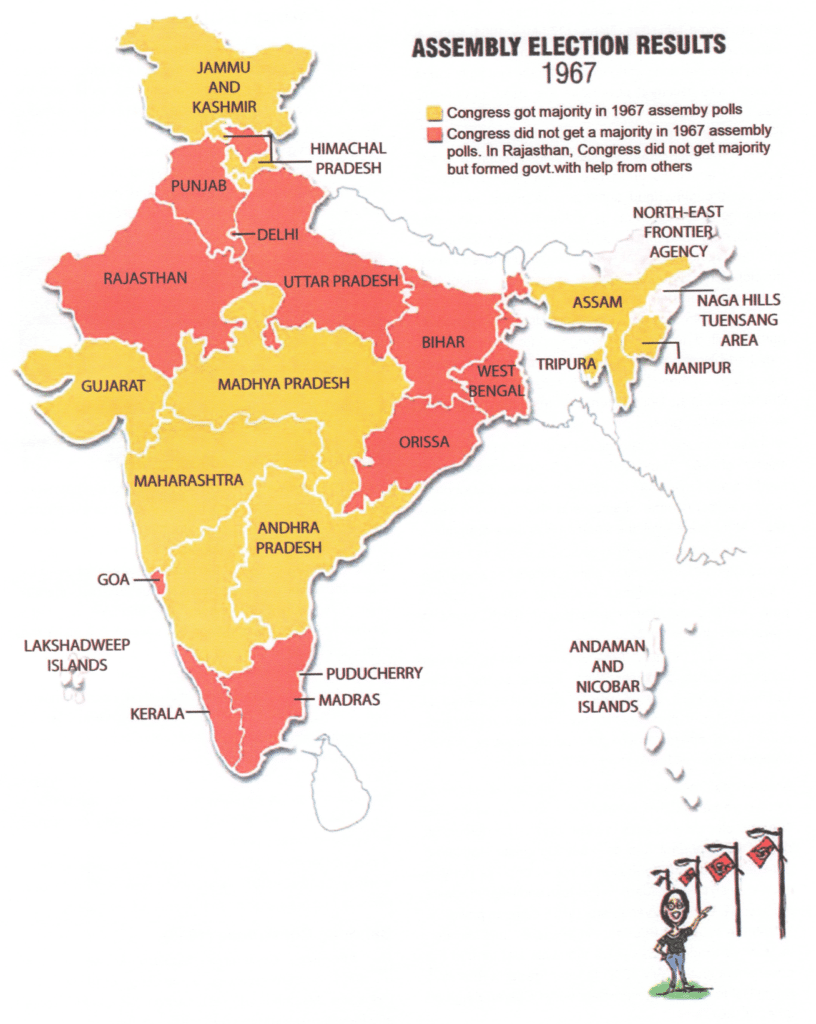
Foreign Policy
After independence, India started engaging with the rest of the world as a sovereign state. India got its independence amidst challenging international developments, with the world just coming out of the devastating Second World War and issues of reconstruction, and many new countries were emerging with the end of colonialism. Also, the British Indian government left behind many international disputes, issues emerging due to partition and need of poverty alleviation. All the above concerns reflected in India’s foreign policy.
The foreign policy was shaped considering its requirements, ideology of national leaders, cold war, colonial experience and imperialism among other factors. Indian followed a policy of friendship and cooperation with all the countries of the world regardless of the political system followed by them. India put great emphasis on establishing friendly relationship with its neighbours. The principle that India
followed reflected respect for the sovereignty of all the states and maintenance of peace. This principle is also reflected in the Directive Principles of State Policy.
The foreign policy of a country is moulded by both domestic and external factors. Thus, the noble ideals that inspired India’s freedom movement also influenced its foreign policy. India achieved its independence when the Cold War was just beginning. This era reflected confrontation between the two superpowers of the world, the US and the USSR, at many different levels including economic, political and military levels.
It was believed that aligning with any of the superpowers would drag the nation into unnecessary confrontations which would not serve the real interest of the nation.
Bandung Conference (1955)
- The Afro-Asian Conference-popularly known as the Bandung Conference was a meeting organised by Indonesia, Myanmar (Burma), Ceylon (Sri Lanka), India and Pakistan at Bandung (Indonesia) in 1955.
- The Bandung Conference grew out of an increasing sense of frustration and alienation among the so-called “nonaligned” nations of Africa, Asia, and the Middle East. These were nations that preferred to remain neutral during the Cold War, believing that their interests would not be served by allying with either the United States or the Soviet Union.
- In April 1955, representatives from 29 “non-aligned” nations of Asia and Africa, including the five sponsor countries gathered in Bandung, Indonesia to discuss peace and the role of the Third World in the Cold War, economic development, and decolonization. The core principles of the Bandung Conference were political self-determination, mutual respect for sovereignty, non-aggression, noninterference in internal affairs, and equality They condemned colonialism, decried racism, and expressed their reservations about the growing tensions (Cold War) between the United States and the Soviet Union.
- A consensus was reached in which “colonialism in all of its manifestations” was condemned, implicitly censuring the Soviet Union, as well as the West. In addition, racism in all forms was likewisely criticized, including the apartheid system of South Africa. The assembled nations, also, called for an end to the nuclear arms race and the elimination of atomic weapons . Moreover, the Cold War struggle between the United States and the Soviet Union had little meaning to nations battling for economic development, improved health, and better crop yields, and fighting against the forces of colonialism and racism.
- As decolonization progressed in the following decade, friction amongst the conference’s members increased; the concept of Asian-African solidarity became less and less meaningful. Major schisms amongst the sponsors of the original conference emerged in 1961, and again in 1964-65, when China and Indonesia pressed for a second Asian-African conference.
- In both instances, India, together with Yugoslavia and the United Arab Republic (Egypt), succeeded in organizing rival conferences of non-aligned states that refused to take the strong anti-Western positions urged by China and, in 1964-65, by Indonesia.
- In 2005 , on the 50th anniversary of the original conference, leaders from Asian and African countries met in Jakarta and Bandung to launch the New Asian-African Strategic Partnership (NAASP). They pledged to promote political, economic , and cultural cooperation between the two continents.
Non-Alignment Movement
India’s needs were to fight poverty, illiteracy and disease. Thus, India required an environment of peace and quiet to start the process of development. It was realized that without sustained development, a country could not be truly free. It would remain dependent on the richer countries including the colonial powers from which political freedom had been achieved. Thus, India neither joined nor approved the Baghdad pact, the Manila treaty, the CENTO and SEATO among other treaties. To achieve all the above objectives, a new ideology “Non-Alignment Movement” was conceived.
The NAM was founded during the collapse of the colonial system. As a result, more new nations were getting Independent. The Non-Alignment Movement was conceived by five leaders Yugoslavia’s Josip Broz Tito, India’s Jawaharlal Nehru, Egypt ’s leader Gamal Abdel Nasser, Indonesia’s Sukarno and Ghana’s Kwame Nkrumah. These five countries got independent around the same time. They required a period of peace and stability to carry on with their nation building process. This required an independent policy outlook divorced from the Cold War rivalry . The first summit was held in Belgrade in 1961. Over the years, the membership of NAM has expanded as the philosophy has found acceptance the world over.
NAM should not be confused with isolationism or neutrality. Isolationism means remaining aloof from world affairs but NAM countries, including India, have played an important role in negotiating peace and stability between USA and USSR alliances. Similarly, neutrality means staying away from war, not to take sides in a war but NAM countries were actually involved in wars for various reasons and also worked to prevent wars.
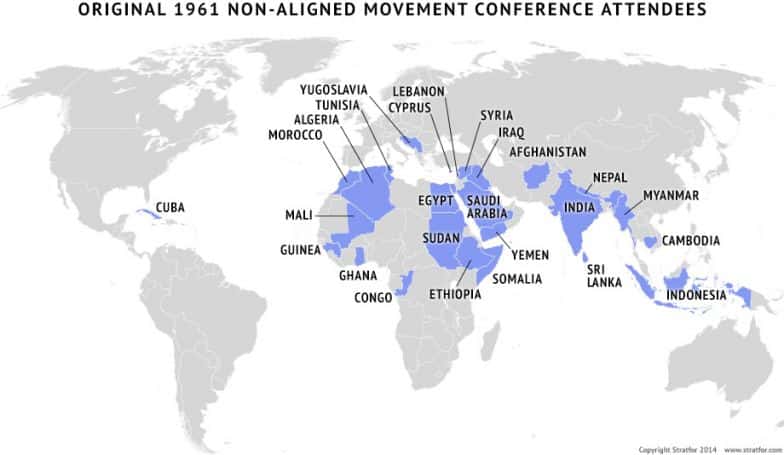
Importance of NAM to India
- Non-Alignment Movement allowed India to take international decisions and stances that served its interests rather than the interests of the superpowers and their allies.
- India was often able to balance one superpower against the other. If India felt ignored or unduly pressurized by one superpower, it could tilt towards the other. Neither alliance system could take India for granted nor bully it.
- India was criticized for this Non-Alignment policy on various occassions. It was alleged that in the name of pursuing the national interest, India often refused to take a firm stand on crucial international issues; thus, making the policy “unprincipled”. India was also criticized for taking contradictory stance on similar issues, for example: India criticized others for joining alliances but signed the treaty of friendship with the USSR for 20 years in 1971, though India maintained that this was necessary due to Bangladesh crisis.
- India was in favor of using the platform to sustain peace in the world. Using the platform, India tried to soften the cold war rivalries of the two superpowers. In doing so, India was committed to not let differences between the two alliances escalate into full scale war.
- For this purpose, India mediated between cold war rivals including that in the Korea war in 1950s. The finest moment for India’s policy of Non-Alignment came when it successfully brought the civil war to an end in Congo.
- Following the same policy, India’s fairness was recognized by the world powers while dealing with the Suez Canal crisis of 1956.
- With the disintegration of the USSR and resultant end of the Cold War in 1991, it led to weakening of the Non-Alignment Movement policy. Though, NAM contained ideas which are still relevant, it was in recognition to the fact that poor and small countries can become powerful and influential in world affairs if they stand united. It reflected an ideology that a sovereign state, no matter how big or small, can pursue independent foreign policy based on its own assessment and needs. The movement was also a recognition to the need of democratizing the international institutions which is still very much relevant in the backdrop of demand of emerging countries to give them a greater share in the international bodies like the UN, WTO and World Bank among others.
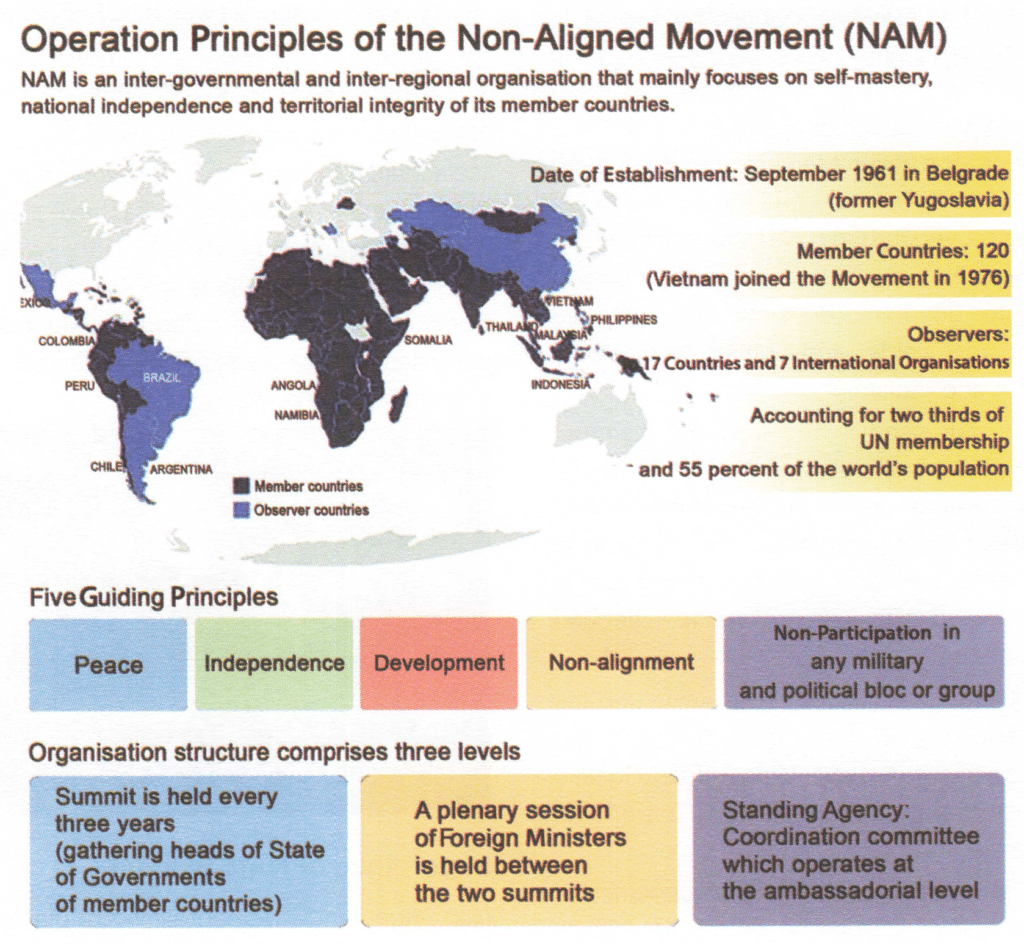
The Panchsheel Agreement
The word “Panchsheel” is described in the ancient Buddhist scriptures denoting ‘five taboos’ governing the personal behavior of Indian monks. This idea was taken up by Nehru to guide the relationship amongst the international states. Nehru proposed the same idea to govern IndiaChina relationship. The agreement was actually a trade pact between India and China streamlining their bilateral trade operations on Tibet. For this, the negotiations were held in Beijing in 1953-54.
Panchsheel, or the Five Principles of Peaceful Coexistence, first found acceptance in Agreement on Trade and Intercourse between the Tibet region of China and India. Based on this, India and China had agreed to follow the following five principles in conduct of their relationship:
- Mutual respect for each other’s territorial integrity and
sovereignty, - Mutual non-aggression,
- Mutual non-interference,
- Equality and mutual benefit, and
- Peaceful co-existence.
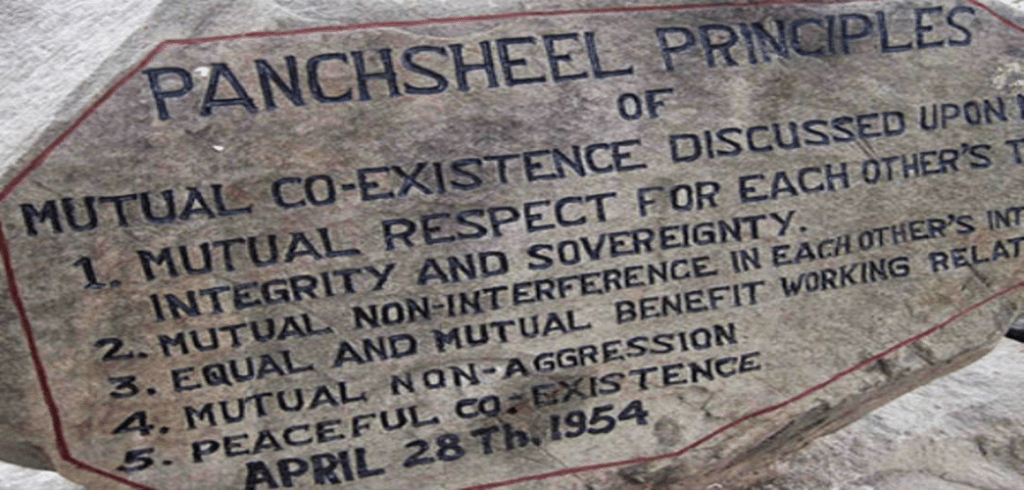
The Panchsheel agreement benefitted China more, at least, in practical terms. Under this agreement, India voluntarily gave up its military, communication, postal and other rights which it had inherited from the British in accordance with the Anglo-Tibetan Treaty of 1904. India did not demand any reciprocal concession. It is often said that the border dispute between the two countries could have been solved at that time. However, by signing the treaty and bringing China into the fold of the principle of “Panchsheel”, India believed that it would permanently resolve the border disputes with China. Moreover, Nehru assumed that the five principles of peaceful coexistence would automatically reduce most of the existing differences and uphold peace in the region.
Later in 1954, both the countries elaborated their vision of Panchsheel’s framework, not only for relations between the two countries, but also for their relations with all other countries, so that a solid foundation could be laid for peace and security in the world. It was envisioned that it would give voice to the newly independent countries as well as work towards lessening the chances of war and strengthening the cause of peace all over the world.
The agreement was lauded world over for its potential role in ensuring peace in the world. And, thus, during the 1955 Bandung Conference of 29 Afro-Asian countries, Panchsheel tenets were incorporated into the Ten Principles of International Peace and Cooperation enunciated in its declaration. The United Nations General Assembly, also, unanimously accepted these tenets in 1957. The same were, also, accepted as the principled core of the NonAlignment Movement. Essentially these principles stand for non-use of force, approach of tolerance and peaceful co-existence. It allows all the nations to work towards peace and prosperity in cooperation while maintaining their national identity.
India-China Relations
India and China both emerged as independent nations in 1947 and 1949 respectively, though they were diametrically opposite in terms of approach to gain independence; India achieved its independence through non-violence whereas China achieved it through civil war.
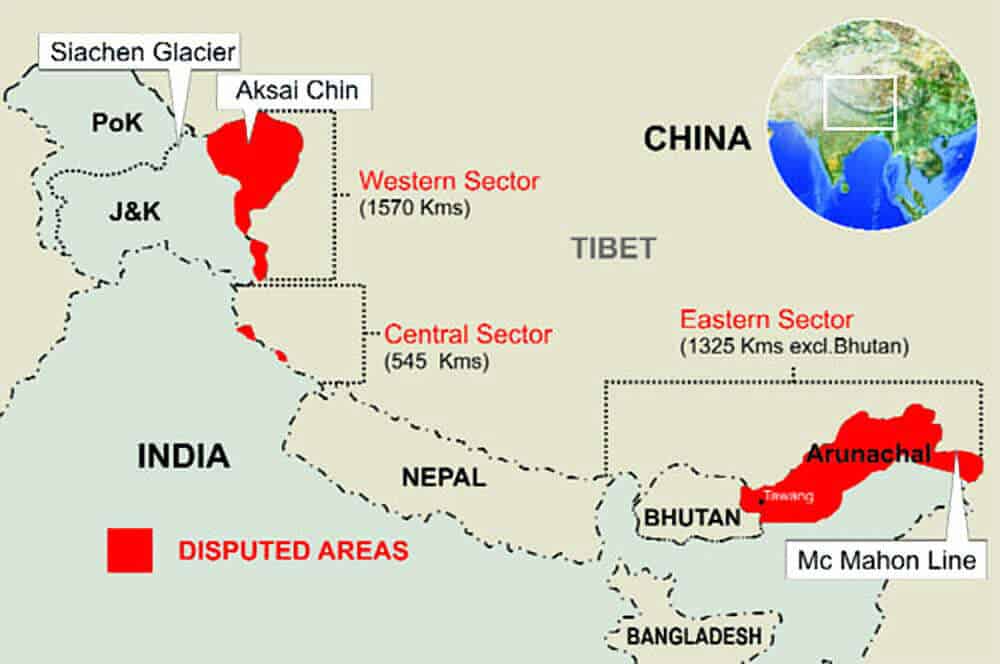
Tibetan Crisis
Tibet is a plateau of the central Asian region that acted as a buffer state between India and China before its annexation by the latter. From time to time in history, China had claimed administrative control over the region and often, Tibet was independent, too. Tibet was the first issue over which the relation between India and China worsened.
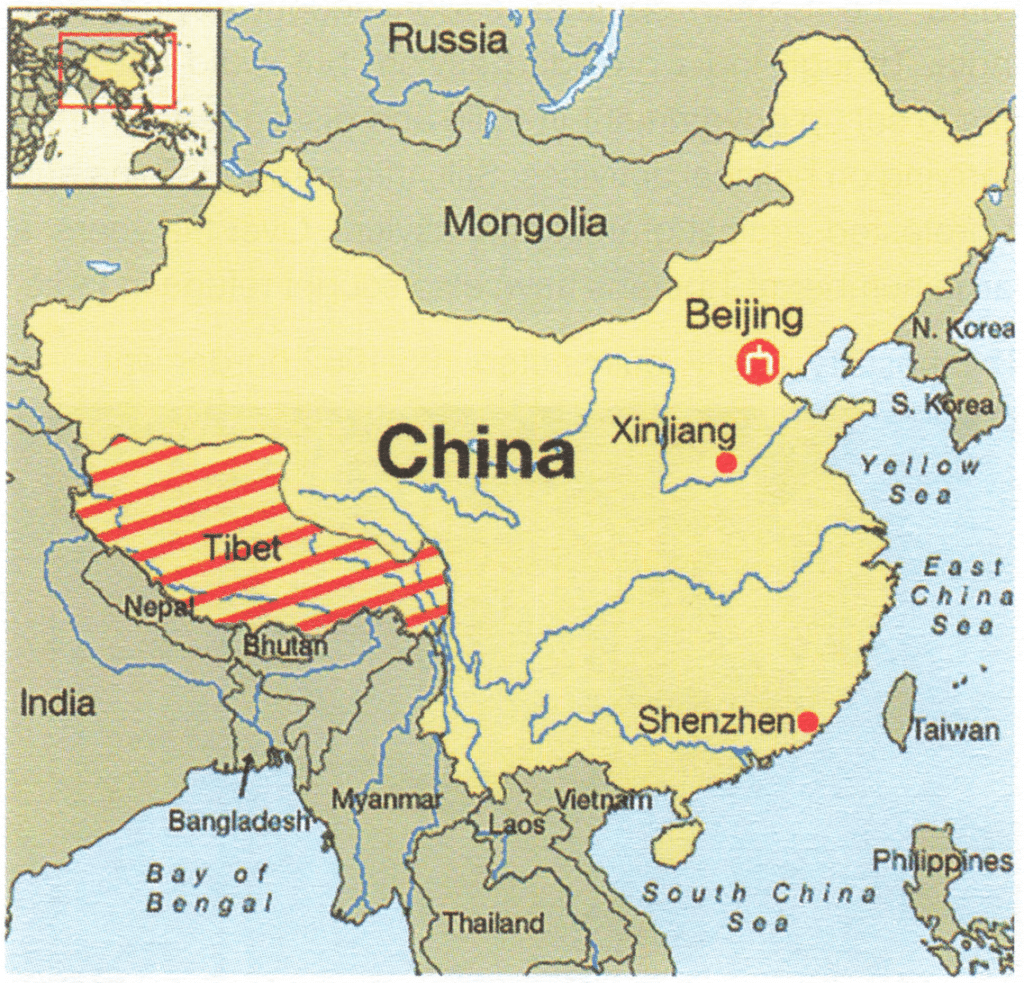
After gaining independence, China was eyeing to incorporate Tibet into its main territory. Thus, China attacked the eastern part of Tibet in October 1950 and went on to occupy Chamdo region. India protested against this aggression and deplored Chinese invasion of the region. To normalize the situation, India offered to mediate. But China opted to use force rather than to resolve the situation
by peaceful means. China claimed Tibet as an integral part of China. According to China, the problem of Tibet was purely a domestic issue. Thus, India’s offer of mediation was rejected. China continued to claim Tibet as its integral part though there were continuous large scale protests.
In 1954, the Panchsheel agreement was signed between India and China. Through one of its clauses about respecting each other’s territorial integrity and sovereignty, India recognized China’s claim over Tibet region. At that time, China also assured India that Tibet would be given much greater autonomy, though the commitment remained elusive. In 1958, Tibetan guerillas revolted against China’s
occupation of the region to liberate Tibet from China’s dominance and regain its lost autonomy.
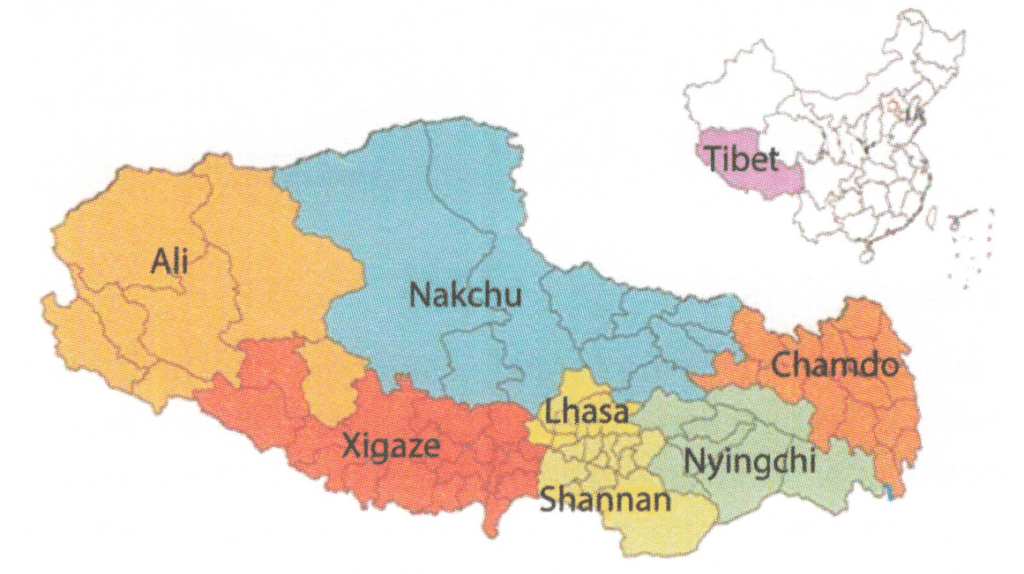
Considering the deteriorating situation in Tibet, Dalai Lama, the Tibetan spiritual leader, sought asylum from India. Though India provided asylum but it did not allow him to set up government-in-exile and dissuaded him from carrying on political activities. Still, this enraged China and it protested against granting the asylum. Over the years, a large number of Tibetans have also sought refuge in India.
This hostility, finally, culminated into 1962 border war.
Currently the situation is that China has created the Tibetan autonomous region as an integral part of China, which the Tibetan people resist. Tibetans also dispute China’s claims that it has granted ‘autonomy to region’.
1962 War
Amongst all the neighboring states, India shares, its second longest border with China. This border is complicated by two factors. First, Tibet used to act as a buffer state in the past but its annexation by China complicated the border issue. Second, the border was decided by the British Empire. The border between India and Tibet was delineated by the McMohan line which China refused to recognize.
China was also interested in Aksai Chin, a part of eastern Ladakh, to connect Tibet and Xinjiang by road. At the same time, China also claimed the region south of eastern end of McMohan line. India administered this area as the North East Frontier Agency (NEFA), now known as Arunachal Pradesh, which is recognized by China as South Tibet. Though, historically, Tibet used to claim the area, it ceded
the territory , in 1913-14 as, part of Simla Accord which also saw the drawing up of McMohan line.
With Chinese invasion of Tibet, India hoped that the border dispute can be resolved through McMohan line. In 1958, India got to know that China was building a road through Aksai Chin, an Indian territory that time. Soon, China started showing Aksai Chin as its territory in its maps. When India protested, China counterbalanced the issue by protesting against Indian decision of providing asylum to Dalai Lama. Several discussions and correspondences failed to resolve the issue.
Border skirmishes continued and, in October 1962, China launched a swift and massive attack on both Aksai Chin area and NEFA . Though China withdrew swiftly in the face of opposition of both the USA and the USSR, but it retained Aksai Chin leaving NEFA in Indian control. The war had ended but not before humiliating India and denting its image the world over.
India took a long time to recover from this humiliation. Many of the top army commanders gave up their posts and the then defense minister had to leave the cabinet. Even Nehru faced his first No-Confidence Motion over his failure to properly assess the Chinese intentions. India’s foreign and security policy took a definite change after the war. Within two years, China conducted nuclear test and India had to increase defence investment. Thus, India’s nuclear test was the result of threat posed by both Pakistan and China. Also, the war made the India-China conflict a part of global cold war, as India signed a Friendship Treaty with the USSR and China improved its relationship with the USA. Thus, the war took a heavy toll on India-China relations and it took many years to normalize the relations again.
Analysis of Nehruvian Era
The period 1947-62 is known as Nehruvian era in the Indian history. During this period, Pt . Jawaharlal Nehru became the first prime minister of India and held the position till his death in 1964. He dominated the scene during their years. He was praised and condemned for his successes and failures. But, it was a fact that there was none to match his stature.
Achievements
- Integration of India: The political integration of India established a united nation for the first time in centuries from a plethora of princely states, colonial provinces and possessions. Despite partition, a new India united peoples of various geographic, economic, ethnic, linguistic and religious backgrounds.
- Calamities caused by partition: A big challenge for the first government was to overcome the calamities caused by partition of India which were in the form of communal riots and refugee problems. With continuous efforts, soon the country moved out of these issues. Challenge of framing the constitution: To frame a constitution was not an easy task. The framers had to face many issues including nature of polity, minority safeguards and fundamental rights among others.
- Democracy: Political stability during the Nehruvian era provided sufficient time for the democracy to take roots.
- Free and Fair elections: Given the sheer size and diversity of the nation, it was a humongous task to realize the Universal Suffrage rights provided to the citizen, making them equal partners in governance. Task of formulating foreign policy: In the Cold War era, it was very difficult to develop independent foreign policy especially for a nation who had just achieved independence and struggling to come out of poverty. It was the era when India championed the Non-Alignment Policy.
- Problem of economic growth: At the time of independence, India was amongst the poorest countries of the world, with more than 80% population living in rural areas. Thus, to transform an underdeveloped and backward economy into a fast developing economy , it needed continuous well planned efforts. For this purpose, Five Year Plans were developed and industrialization was focused upon. Though the problem of poverty still persists, it has come down significantly and the political stability provided in the Nehruvian era, prepared the ground for rapid economic growth seen in later years.
- Linguistic Reorganization: It was a formidable task but was completed with a considerable amount of fairness which ultimately strengthened the integrity of the nation.
Shortcomings
- Indo-China war 1962: Nehru is often criticized for being naive in judging the intentions of China and being militarily underprepared to face the military action from our neighbour.
- Issue of Kashmir: Nehru has also been criticized for dragging the issue to the United Nation assembly unilaterally when the army was in complete control of driving out the enemies of Kashmir borders. The cease-fire line now has become the line of control between India and Pakistan, continuing the border dispute with Pakistan.
- Indo-China border dispute: Nehru is, also, criticized for showing lack of vision during Panchsheel agreement over Tibet when he voluntarily recognized China’s claim over Tibet. Reciprocity could have been employed at that time to make China recognize NEFA as integral part of India, in exchange of recognizing China’s claim over Tibet. It would have settled the border dispute with China.
- Ignorance of Agriculture: Excessive focus on development of heavy industries, especially in the initial years including the Mahalanobis plan, have resulted in ignorance of Agriculture sector and soon India faced food shortage and had to ask for food aids from other countries.
- Closed economy: Though the aim was to build selfreliance, the closed economy system led to depleted foreign exchange reserves which ultimately culminated into 1991 crisis when India faced BoP crisis.
Conclusion
It should be understood that it was the stability provided during this period which has largely prevented India from going down the path that its neighbour, Pakistan, had gone too. It was the period which provided enough time for the democracy to take roots. It was also the vision of the leaders like Nehru, Sardar Patel, Ambedkar, etc. amongst others that India still stands united even after facing
extremely difficult issues and made its presence felt on the international stage, too.

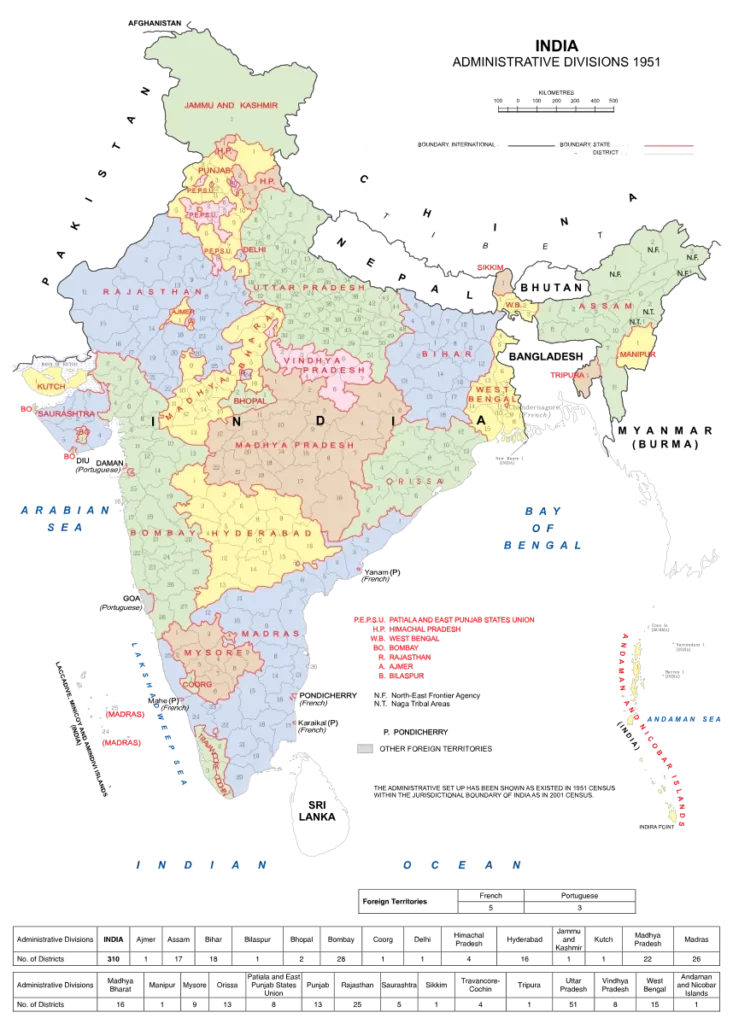
are these complete?